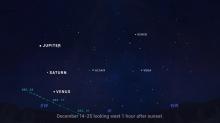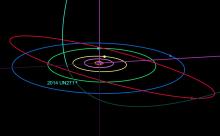Listen to today's episode of StarDate on the web the same day it airs in high-quality streaming audio without any extra ads or announcements. Choose a $8 one-month pass, or listen every day for a year for just $30.
You are here
Orionid Meteor Shower
The Orionid meteor shower should be at its most active late tonight. And there’s no Moon in the sky then, so it should be a pretty good show.
The shower is known as the Orionids because all of its meteors appear to “rain” into the sky from Orion the hunter. The constellation climbs into good view after midnight, so that’s when the shower is at its best — between midnight and dawn.
The meteors are bits of debris from Comet Halley. The comet sheds grains of dust as it orbits the Sun. When Earth crosses the comet’s path, some of those grains plunge into the atmosphere. They instantly heat up and vaporize, creating the streaks of light known as meteors.
Most of the dust grains are no bigger than pebbles. But a few are larger. They form brilliant streaks that are visible even in a moderately light-polluted sky. And some of them can leave glowing trails that remain visible for a couple of minutes.
The shower has been declining in recent years. Halley’s Comet is near its greatest distance from Earth, so there aren’t as many bits of comet dust in this part of its orbital path. But the number of meteors appears to vary over a period of a decade or so. There’s evidence that the number is heading upwards, so the shower could produce 20 or more meteors per hour at its peak.
To watch the Orionids, find a dark but safe site away from city lights. Bundle up against the autumn chill, then sit back and watch the sparks from Halley’s Comet.
Script by Damond Benningfield






